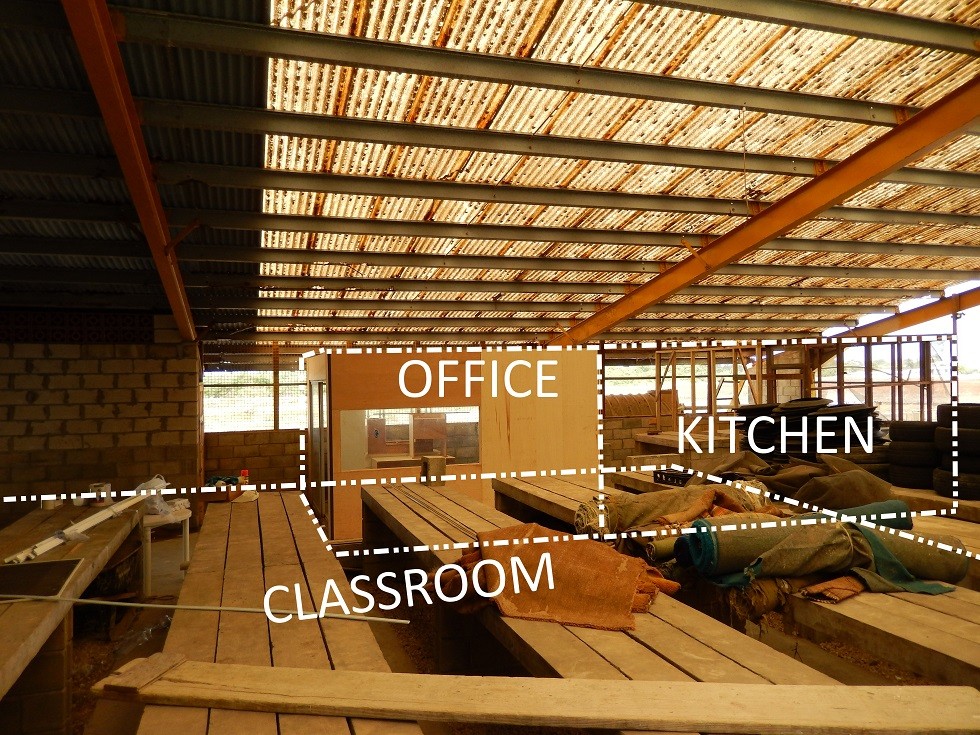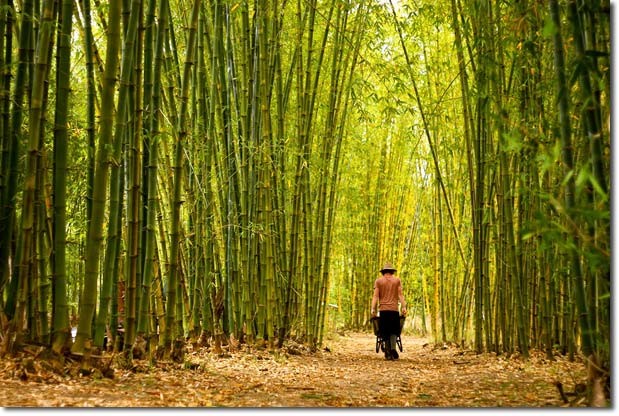A Permaculture Primer The Permaculture Research Institute
Post on: 16 Март, 2015 No Comment

by Adrian Buckley. Permaculture Designer, B. of Community Design, Calgary, Canada
Permaculture is a shortened form of perma nent culture. While it evades any single definition, permaculture can be defined as a system of design assembling conceptual, material and strategic components into a pattern which functions to benefit life in all its forms. Permaculture design is concerned with the design of natural and human systems so that they can sustain themselves by their own means, permanently. I am writing about permanent culture because it doesnt only apply to creating permanent agriculture, but also to creating self-sufficient human settlements.
As I go about making sense of the world and the relationships between things around me, I hold a certain bias: that the most important investment of our personal energies and resources is about getting our houses and gardens in order so that they feed and shelter us, and provide all of our needs. I think that we as individuals are capable of becoming producers instead of consumers, if we choose to. My bias follows that we do not need to wait for elected politicians to solve the worlds problems. There are accessible and solutions-based strategies we can adopt right away that will immediately benefit us and our ecologies at the same time.
My bias includes what has already been defined in ecology that living things behave as a forest ecology where a whole diversity of plants and animals each have a function, and together these functions lead to a climax state where the forest reaches maturity. We can arrange living and non-living things into cooperative relationships to achieve a resource-producing climax state in our communities, lessening our need for external resources and industries. Cooperation, not competition, is the key.
We have the capacity to put our cultural sentiments aside (such as the modern ideas of progress ) and make simple design choices to meet 100% of our food, freshwater, clean energy and shelter needs through mutual cooperation. I do not intent to change anyone through permaculture ethics. Instead I wish to provide everything I know about permaculture to interested persons so they can apply and teach it while getting their houses and gardens in order to meet all their needs locally.
I feel that for any choice to be a sustainable one, we need to follow an ethic of earth care, people care and return of surplus.
Care of Earth
This is a life ethic. All living things are not only means, but ends. In addition to their instrumental value to other creatures (including us), they all have intrinsic worth. We are not apart from ecology. Our health is directly related to the health of our environment. When we think about past famines and crises, it can become clear that all of these are a result of a disturbed environment. This ethic involves the widening of human survival to include the idea of the survival of natural systems.
Care of People
Care of People means ensuring that human needs are met, because if they are not, we engage in destructive activities that harm our planet. Through Care of People we make the choices to ensure that we have food, shelter and all the things we need to do our jobs.
Return of Surplus
This ethic involves the contribution of surplus resources and activities toward the aim of Care of Earth and Care of People. Once our own needs are met, then our surpluses can be contributed to provide the resources and influence for others to do the same.
Perhaps you have heard about the Three Sisters corn, beans and squash. When planted together, each of these plants do better than if they were planted alone. The corn provides a living trellis for the bean plant to grow on and reach full sun. The squash, with its big leaves, shades the system and prevents evaporation. Finally, the bean, a leguminous plant, fixes nitrogen into the soil, benefiting the corn and squash. This is an example of a guild an arrangement of living things that together benefit from its association with each other. In the human sense, what is the equivalent of a guild? A community.
In permaculture, our job is simple: to exercise our power of arrangement. Building productive communities means arranging the things that make up that community so that they are connected to each other by relationships that provide benefit that otherwise would not be there without that relationship.
Diversity of Connections
As more beneficial connections are made between people and organizations in a community (and living and non-living things in an ecology), there are more chances for useful exchanges of resources and energy between elements in the community. As a result, these resources are constantly recycled in the community and take a long time before they finally leave. A diverse community containing a number of cooperating organizations connected to each other beneficially can, by design, keep money recirculating within it. These beneficial connections also mean the higher likelihood that the needs of one element can be fulfilled by another components yield. As an example, think again about the Three Sisters. The corn has an important yield a living trellis for the bean to climb on. The bean has an important need the need for something to climb on, which is fulfilled by the corn. The corns need is nitrogen for growth, which the bean provides in exchange for trellis services.
In human communities, we can design in a diversity of people and organizations that benefit from each others services in the exact same way removing the need for destructive and external industries for economic survival. As diversity increases, so does local productivity.
Yield and Functional Design
Yield is the sum total of useful energy storages in a system. It is more than just product per acre etc. The reason that much of our agricultural and economic systems fail is because we ask only one yield of resources in these systems. For example, water. When we turn on the tap to wash our hands, that water then flows directly to the municipal sewage system. In other words, it flows directly from source (the tap) to sink (the water treatment plant). Thats only one use. However, we can use design to place components differently in a system so that every drop of water is used more than once as it flows through our system. For example, we can connect our sink to our toilet reservoir, so that we can only flush the toilet if we wash our hands (2 uses). Better yet, we could install a rain collection system onto the highest point on our property and provide our tap with a gravity-pressured water source. Now were at 3 uses. If our property size permits, we can even go a step further: we can use our blackwater from the toilet to filter through a constructed micro-wetland or greywater reed bed system on our property to provide nutrients and water to our food-producing garden (blackwater is not pollution, just an underutilized resource). Thats 4 uses of the water. To look at this in another way, its like having every litre of water you use come with three more litres. This extra water comes entirely from the placement of components (rain barrel, tap, toilet reservoir and wetland) so that they are usefully connected.
When planning our relationships with other people and organizations in a community, money plays the same role as water it transports trades and businesses. I think it is essential in any local economic development effort that for every dollar entering that community, the community must be ready to use each dollar three or four times before it leaves. This can be achieved through a diverse network of ethical businesses working in cooperation.
Ethical Business
All truly sustainable systems produce all their energy and resource needs from within that system. This is quite opposite from todays realities. Our industrial, agriculture, and financial systems are all examples of systems that we are intimately involved in for our own survival and which draw on resources and energies that come from some other part of the world. If those dont come in tomorrow, then these systems can no longer support us. Drawing lessons from ecology, we can transform our communities into self-regulating systems, or guilds, that provide all of its needs (and for everyone in it) from within. You can start this process tomorrow by starting an ethical business.
An ethical business is an organization that invests and contributes to the benefit of the system that supports it while at the same time ensuring that your needs are met. It is an organization (even a for-profit one) that follows the ethics I described earlier care of earth (conducting a type of business that makes little or no impact on natural systems or even improves them), care of people (being a entity that provides other organizations and people in the community with the things they need locally so that they do not depend on resources and energies from outside, or worse yet, have to harm the environment out of necessity of meeting their needs), and finally return of surplus (re-investing time, profits, influence and energy back into the system and community so that others can use them for the aims of earth care and people care. In other words, this means that we as community members meet our own needs without destroying the planet, and re-invest our profits back into the community to ensure that it guarantees the right conditions for our living.

Ethical Investment
There are generally five kinds of resources in our world:
- Those that increase with modest use (such as human expertise)
- Those unaffected by use (such as solar and wind energy)
- Those that disappear or degrade if not used (such as food)
- Those that are reduced by use (such as fossil fuels)
- Those that destroy or degrade other resources if used (such as chemical pesticides)
If we choose that we as individuals and organizations want to build sustainability into our industries and communities, we must concentrate on using those resources described by 1 to 3. It is okay to use resource described by 4 if they are used as investments to enable the proliferation of the first three. Resources described by 5 are nothing more than destructive and should be avoided.
Todays debt-based money system values debt. When we make financial investments, we are investing in debt, which has obvious consequences, and is responsible for the economic instability we are all familiar with. Ethical organization needs to make ethical investments investments toward things that give life, such as healthy soil, healthy ecosystems, and local food production. If a community has a local currency that is based on the very things that enable that community to survive, then that currency will actually have value. You can start by making the following investment priorities:
- elements that produce a yield (such as local soil building and food production projects, education and skill-building, making an ethical business that follows the ethic of earth care, people care and return of surplus)
- elements that save resources and energy (such as energy saving appliances)
- elements that consume energy (cars, houses)
Investing in consumptive elements is not always bad. I am in the process of buying a new overhead projector because I currently do not have access to one, and such a good will help me teach permaculture courses, of which will result in empowered people who move on to restore landscapes and make sustainable economies.
Here I would like to acquaint you with Willie Smits, who spoke at a TED conference. This has been one of the most influential accounts of community empowerment I have ever seen. The video is 30 minutes long, so read on and then watch it when youre ready .
Ill talk about my own story here, as it is the one I know best. I started Big Sky Permaculture in the fall of 2009 with one primary mandate: to teach permaculture to other people, so that they, if they choose to, can make simple design choices for meeting 100% of their food and energy needs within their communities and households. It all started when I took an introductory weekend permaculture course last year in Canmore from Ravis Sustainable which supercharged me; I was learning about things that deeply resonated with my value system.
Working at the time as a community and land use planner in a consulting firm, I found that I couldnt easily apply the principles and ethics of permaculture into the planning projects I was working on; there was never scope nor budget. Feeling that these most important steps were not being undertaken, I went deeper into permaculture and attended a two-week Permaculture Design Course (PDC) taught by Jesse Lemieux. Shortly after, I invested myself completely into moving away from the professional planning world and founded Big Sky Permaculture.
But it doesnt stop there. My first imperative is to first meet my own needs while doing education and consulting in permaculture design (care of earth through restoring landscapes to meet human needs locally and through the process protect wilderness from otherwise destructive industries). My second imperative is to teach introductory permaculture courses (and by next year full-length PDCs) so that individuals and communities can learn the design steps and strategies to meet all their energy and food needs themselves (care of people). I charge $250 for an Introduction To Permaculture course, and provide permaculture design consulting for $100 per hour. Where does that money go? It first goes to getting my own house and garden in order to meet my immediate food and shelter needs. Second, it goes to investing in equipment and skills to teach. After that, all profits go in a pot which will be used to start and sustain aid projects that actually empower people and communities, such as larger scale food forestry and earthworks that are designed and implemented by community members, who learn about creating local food and energy security every step of the way so they can do it themselves and teach others (return of surplus).
My secret business strategy is to make myself a cooperative interdependent member of the community by following this ethic. Whats in it for me? Well, Im guaranteeing myself a job while empowering others, and restoring earths life support systems at the same time. And this all began from someone elses surplus that was passed on to me.














